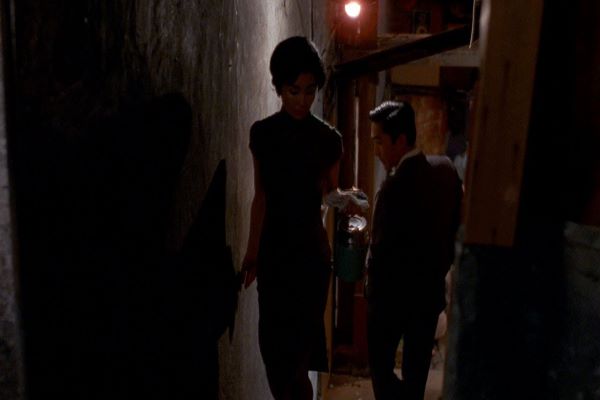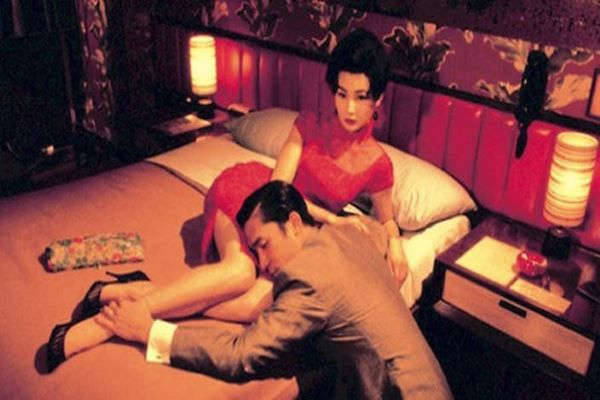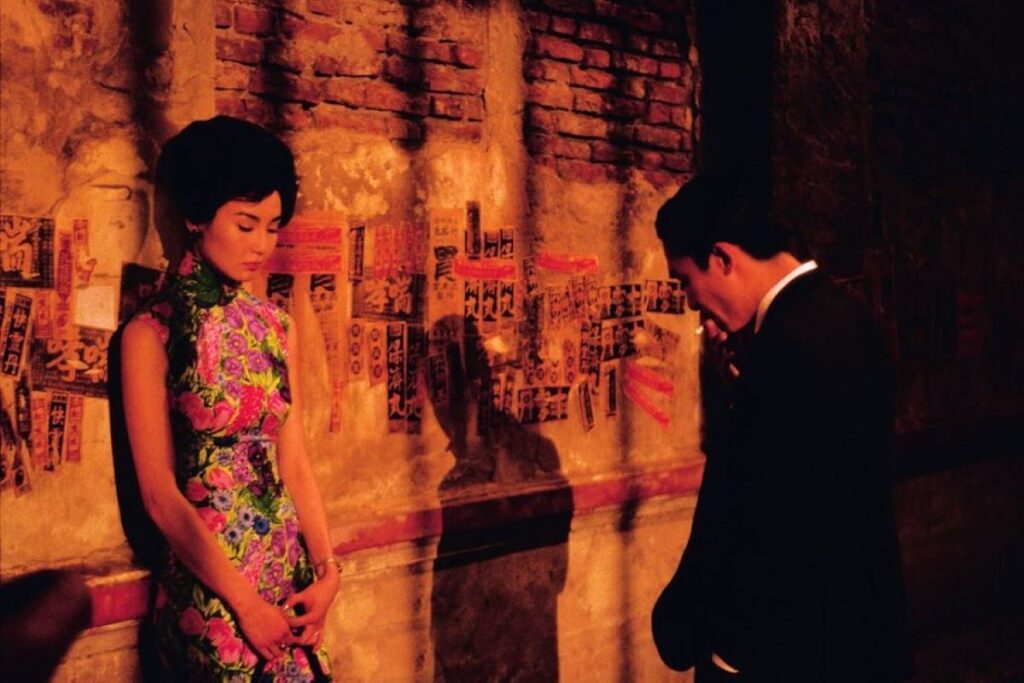Through In the Mood for Love, maverick filmmaker Wong Kar-wai pays a heartfelt tribute to Hong Kong’s bygone era of the 1960s. The film features Hong Kong from 1962 to 1966. Even though the film revolves around an affair, it is not the central theme and objective of the film. Through In the Mood for Love, filmmaker Wong Kar-wai shows 1960s Hong Kong, its inhabitants, and their societal behaviors. He vividly and emotionally portrays the attitude of the citizens toward an extremely sensitive subject like an extramarital affair. The moot point of the film is how they would keep and deal with their secrets. The magnificent cinematography with vibrant colors and lighting creates magic on the screen. Tony Leung and Maggie Cheung are two of the best-dressed characters ever on the screen. Amidst heartbreak, loneliness, and melancholia, In the Mood for Love depicts longing and unrequited love.
The film starts in a big building with multiple cramped flats in Hong Kong in 1962. However, the jubilant Mahjong-playing residents of the building always keep the building bustling with joy, happiness, and enthusiasm. A lady and a gentleman who are elite, good-looking, and superbly well-dressed rent two adjacent flats on the same day in the same building. The lady named Su Li-zhen (Maggie Cheung) or Mrs. Chan is an executive secretary in a shipping company and the gentleman named Mr. Chow (Tony Leung) is a journalist. In spite of the bustling atmosphere of the building, the duo remains lonely as their spouses often work overtime. They notice that Mrs. Chan is holding the same bag that his wife has, and Mr. Chow is wearing the same tie that Mrs. Chan’s husband wears. Their spouses also tend to follow the same work schedule. Slowly they realize that their spouses are having an affair. While writing a martial art serial together, they come closer and develop feelings for each other. Incessant intervention and the curiosity of their neighbors force Mr. Chow to rent a hotel room where they can work uninterruptedly without any disturbances.

Chow emigrates to Singapore but Mrs. Chan could not accompany him as she reaches the hotel a little late. She travels to Singapore, visits Chow’s apartment in his absence, and calls him over the phone but does not utter a single word. Chow gets to know her visit to his apartment from a lipstick-stained cigarette. Three years later, Su Li-zhen visits the same building in Hong Kong and rents Mrs. Suen’s flat as she is about to emigrate to the United States. Chow also visits the same building and learns that his landlord has emigrated to the Philippines and a lady is staying in Mrs. Suen’s apartment. He leaves the building without realizing that the lady is none other than Su Li-zhen. Chow visits Cambodia during Charles De Gaulle’s visit to the country. He visits Angkor Wat temple, murmurs his secret in a hole in the temple wall, and fills the hole with mud.
In the Mood for Love is an incredible creation by filmmaker Wong Kar-wai. This film is his heartfelt tribute to his motherland and his childhood. When the communists took over China in 1949, many Shanghainese families fled Mainland China and found shelter in Hong Kong. However, their culture and behaviors were different from the Cantonese-speaking original residents of Hong Kong. They would not talk or mingle very often with local residents. A Shanghainese parent would not welcome a marriage proposal from the Cantonese community. Wong Kar-wai spent his childhood in this kind of atmosphere in Hong Kong in the 1960s. After the cultural revolution, reverse immigration happened and many Shanghainese families returned to Mainland China after 1966. So, at the end of that decade, Hong Kong changed completely. Through this film, Wong Kar-wai wanted to capture the precious memories of his childhood in the early 1960s British Hong Kong.
Even though Wong Kar-wai shows an extramarital affair in In the Mood for Love, it is not the moot point of the film. He portrays the attitude of the people toward sensitive and taboo subjects like extramarital affairs in that era. He is very much interested in digging deeper into people’s hearts and understanding how they would keep the most sensitive secret. Quite naturally, he draws relevance to the story in which people in the olden days would curve a hole in a tree atop a mountain, whisper their deepest secrets, and then fill it with mud. The most personal secrets can’t be shared with everybody. The most hidden agonies can only be shared with the closest ones. The most yearning desires are not always fulfilled. Humans keep longing for their dearest ones and happiest times. However, their lifelong wishes do not often come true. They keep living in the midst of the most painful and melancholic longing. Still, life goes on.
In In the Mood for Love, Wong Kar-wai vividly portrays loneliness and morality. Amidst a bustling atmosphere, Su Li-zhen and Chow are two lonely souls. They start talking to each other, come closer, and even collaborate in writing a martial art serial. They find solace in each other. Chow rents a hotel so that they can write and spend time uninterruptedly. When he emigrates to Singapore, Su Li-zhen follows him. They realize that they have developed strong feelings for each other. However, they remain bound by their values and morality and don’t cross the line. Su Li-zhen clearly tells Chow that they won’t be like their spouses. They do not allow any negativity to affect their families.

Initially, Wong Kar-wai wanted to make a film in Mainland China and planned for a triptych named Summer in Beijing. He decided the first film to be a love story titled A Story of Food as the couple would meet often at the food stall and the seasons would pass by. However, he had to cancel the project in China as getting filming permission in Beijing was difficult, especially for his spontaneous filming process. After that, he set the film in British Hong Kong in the early 1960s. Despite the location change, the film remains a romantic love story with a food connection. Chow and Su Li-zhen pass each other multiple times in the hallway, corridor, stairs, and alleyway while buying noodles.
The Chinese title of the film The Age of Blossoms or The Flowery Years is taken from a song of the same title by Zhou Xuan from a 1946 film. Wong Kar-wai selected Secrets as the English title for the film. However, the Director of the Cannes International Film Festival advised him to change the title. He changed it to In the Mood for Love after listening to the song I Am in the Mood for Love from the album Slave to Love: The Very Best of the Ballads by Bryan Ferry of Roxy Music. Wong Kar-wai included multiple rainy scenes in the film remembering the devastating Typhoon Wanda which hit and severely damaged Hong Kong on 1st Sep 1962.
Wong Kar-wai did not have any structured screenplay for In the Mood for Love. The entire film was shot based on continuous improvisation. He made it pretty clear to both Tony Leung and Maggie Cheung that the screenplay would not have any structured dialogue. They would have to play their characters emotionally with body language, subtle gestures, and facial expressions. Both of them have performed their parts incredibly well. Urban loneliness, separation, longing, nostalgia, and melancholia get a new visual language in their portrayals of Chow and Su Li-zhen. Maggie exactly looks like a Shanghainese esteemed lady in her full-bloom youth in early 1960s British Hong Kong.
Wong Kar-wai shot this film over a period of fifteen months, which led to his long-time cinematographer Christopher Doyle’s exit from the project midway. Then, Mark Lee Ping-Bing shot the rest of the film. So, the film has both Christopher Doyle’s extremely dynamic and vibrant cinematography and Mark’s wide-angle near static long shots. However, Wong Kar-wai himself influenced the cinematography to a great extent. Magnificent and lush images throughout the film make it an unforgettable and emotional cinematic experience. Any frame of the film looks like an incredibly rich-colored portrait. Throughout the film, the camera observes and follows the characters much like a spy. Often, scenes are shot through a medium like windows, which makes the entire film look like a private space of Mr. Chow and Mrs. Chan as if the viewers are eavesdropping unethically. Multiple times, images of Chow and Su Li-zhen are reflected in the mirror as if they are situated in an obstructive closeness. Rarely films are made up of so many incredible shots.
Wong Kar-wai uses multiple soundtracks in the film. Shigeru Umebayashi’s Yumeji’s Theme has become the signature tune of the film. Nat King Cole’s Aquellos Ojos Verdes, Te Quiero Dijiste, and Quizas, Quizas, Quizas add favors of the golden olden days to the film. Music director Michael Galasso’s Angkor Wat Theme and Casanova touch hearts. Editing the footage shot over a period of fifteen months into a ninety-eight minutes film is a mammoth task altogether. Editor William Chang has done a brilliant job. In the Mood for Love will always be remembered for its costumes, makeup, and hairstyling. Tony and Maggie are two of the best-dressed, elegant, stylish, refined, and beautiful characters ever on the screen. In the Mood for Love was nominated for the prestigious Palme d’Or at the 2000 Cannes Film Festival where Tony Leung won the Best Actor award. It was nominated for the BAFTA Award for Best Foreign Language Film at the 2001 BAFTA Awards. The film has won numerous prestigious awards all over the world.
